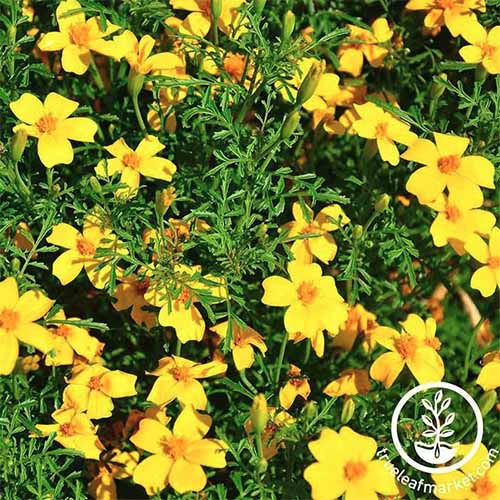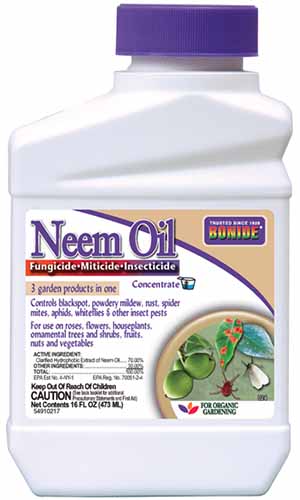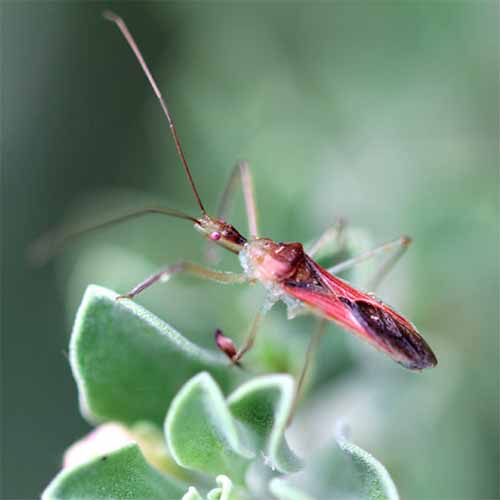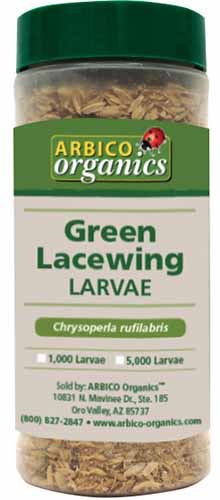Tagetes tenuifolia
Marigolds are widely recognized as one of the easiest plants to grow. They can thrive in various soil types, bloom from summer to autumn, and are incredibly hardy.
In short, marigolds are marvelous.

We link to vendors to help you find relevant products. If you buy from one of our links, we may earn a commission.
In this growing guide, we will focus on how to grow and care for Tagetes tenuifolia, or signet marigolds. You may also see this plant referred to as Tagentes signata when purchasing plants or seeds.
Signet marigolds are in the same genus as other marigolds and share many similar features and care requirements as their cousins. In our comprehensive marigold growing guide, you can read more about general care requirements.
Signet marigolds are very special – they have beautiful flowers and a rich culinary background. As a result, they are commonly used as companion plants in edible gardens and grown as ornamentals.
Keep reading to learn how to cultivate signet marigolds in your garden. Here’s what we’ll cover:
What You’ll Learn
I’m a huge fan of edible planting that also offers ornamental interest in gardens – which is where T. tenuifolia really shines. They’re mild-mannered but can spread into unwanted areas if you don’t maintain them, so keep reading for tips.
I’ve been daydreaming about companion planting signet marigolds in my raised vegetable beds and enjoying them in a tasty summer salad.
The blossoms are edible and have a spicy citrus taste, and they make an excellent garnish for dishes that need an aromatic lift.
If this sounds like an interesting plant you’d like to include in your garden, let’s get started.
Cultivation and History
T. tenuifolia is primarily referred to as the signet marigold but it is also known as the golden or lemon marigold. Native to Mexico and Central America, signet marigolds can be found growing in gardens all over the world today.
In the United States, these showy plants can grow in USDA Hardiness Zones 2 to 11.

Signet marigolds will usually grow to be around 12 inches tall but they can sometimes attain up to 20 inches in height and have a spread of up to 12 inches.
They bloom from early summer to late fall and need to be deadheaded regularly to promote more blooms.
The flowers come in shades of golden yellow, orange, and deep red, as well as bicolored varieties. The blooms are very compact and small, but when in full bloom they are very showy.
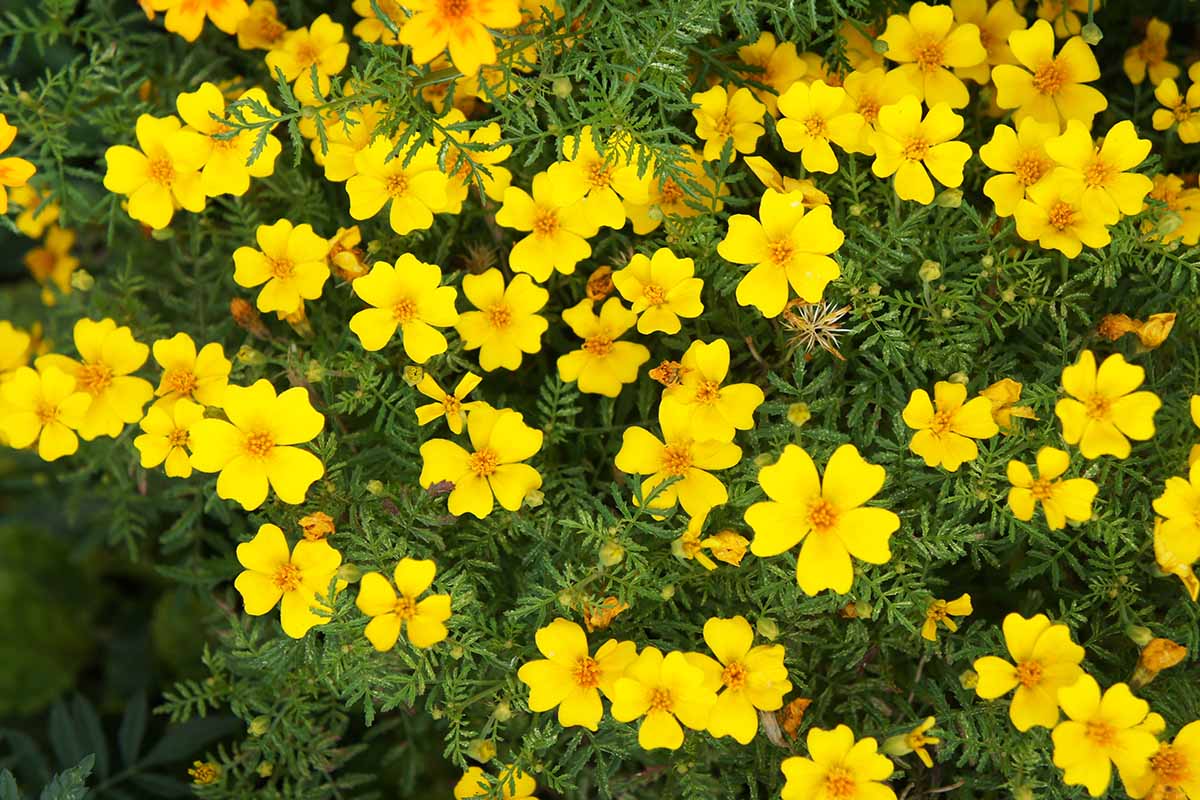
The blooms of T. tenuifolia are edible and smell of citrusy lemon when the petals are bruised. I’ve read that the lemon scent can stay on your hands for up to an hour after handling – this sounds like a good problem to have to me.
The foliage is also magnificent. The leaves are lacy and fine, almost fern-like. When you bruise the stems and leaves they are aromatic, like the blooms, and these are also edible.
Propagation
Signet marigolds can be propagated from seed or grown from nursery starts that are transplanted into the garden. Seeds can be purchased from many nurseries or easily harvested from a mature plant.
From Seed
Like other types of marigolds, seeds can be harvested from a mature plant’s flowers when they begin to visibly dry out, and the petals and base start to brown. Seeds can be harvested directly from the base of the flower.
Carefully remove the dried flower head from its stem by cutting it with a sterile pair of garden shears.
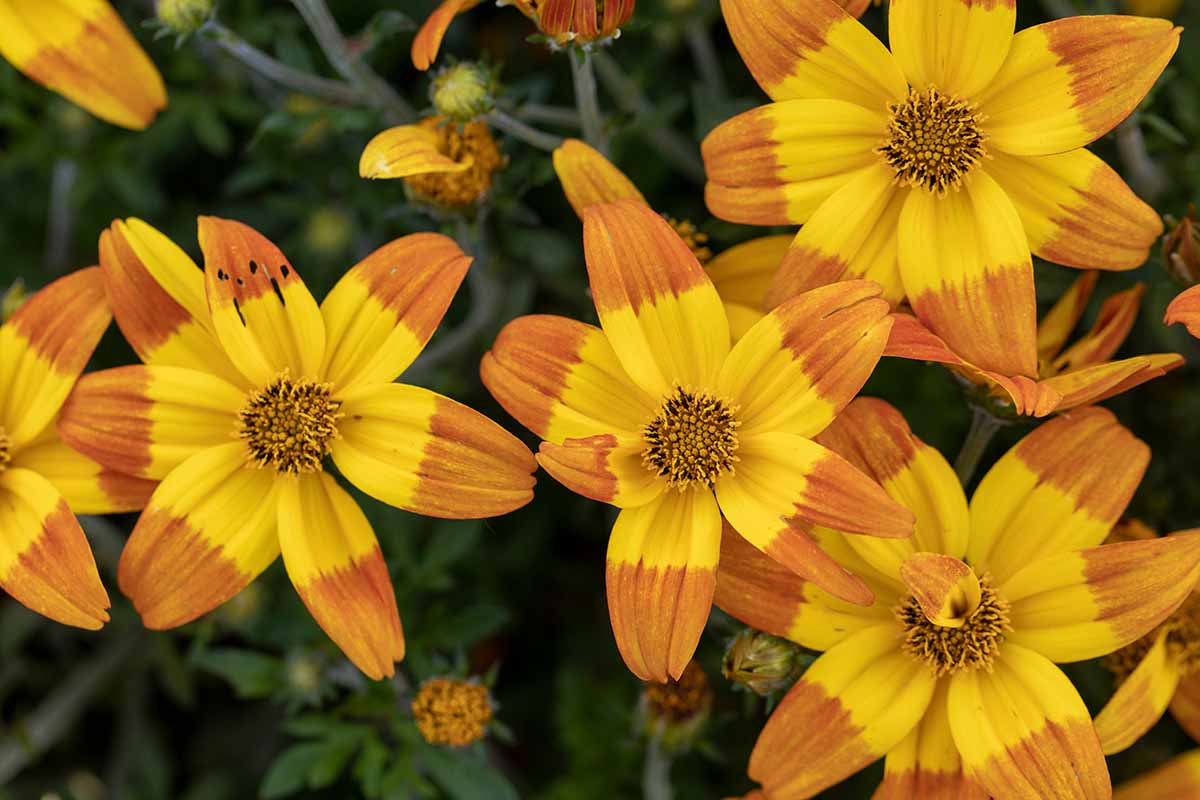
Next, pull the dried petals away from the base of the flower if any remain, which will expose the seeds attached to the base. Let them dry for about a week after harvesting to prepare them for storage.
Here’s my advice on saving your seeds: place them in a reusable glass jar with a small packet of silica gel and store them in your fridge until next year. The most important thing here is to store the seeds in a sealed container in a cool, dry place.
Seeds can be started indoors in a seed tray four to six weeks before your last expected frost date. I recommend using something like this Seed Tray Kit from Gardzen, available via Amazon.

It comes with a dibber and a widger, plus five humidity domes, 40-cell trays with drainage holes, and solid base trays. Fill a seed tray with sterile seed-starting mix and you can get to sowing!
Plant two seeds per cell approximately one-quarter inch deep in your seed tray, and keep the soil moist but not wet.
Place the humidity dome on top and place it in a sunny window or under grow lights.
Expect fast germination – you should see small grass-like sprouts in as little as seven to 10 days.
Remove the humidity dome after germination occurs. If both seeds have germinated within a cell, thin the weakest seedling from each and throw them in your compost bin.
If using a window, turn your trays every day in order to straighten your seedlings, as they will lean towards the sunlight.
Around a week before you’d like to transplant your seedlings, move them outdoors to harden them off and to help them acclimate. Ideally you will move your seedlings outdoors two weeks after your last frost date, but no sooner.
You can also sow your seeds directly into your garden if you’d prefer not to fool with transplanting. These plants can grow in various types of garden soil but will thrive in well-draining, moderately fertile soil.
Signet marigolds are annuals that cannot withstand frost, so plan to sow seeds about two weeks after your last average frost date.
After selecting a sunny and well-draining spot in your garden, loosen the soil and it with compost.
Space your seeds approximately 10 inches apart, planted about a quarter of an inch deep. Water regularly and keep the soil moist.
Marigolds also take very well to growing in containers. Select one six- to eight-inch container per plant. Make sure your pot has one or more drainage holes at the bottom and fill it with a high quality-potting mix with excellent drainage.
Plant two to three seeds in the center of each pot, thinning the weakest seedlings after germination as described above. Water thoroughly until the soil is moist, and water again whenever the top two inches of soil is dry.
If you’re worried about overwatering, you can put your signet marigolds in an unglazed terra cotta pot. Terra cotta pots are porous and water will evaporate quicker than it will in glazed ceramic or plastic.
These are much more forgiving if you accidentally overwater, helping to prevent root rot. Just remember that you’ll need to check the soil moisture more frequently as well.
See our guide to propagating marigolds from seed for more tips.
From Seedlings/Transplanting
You can usually purchase seedlings or young plants from garden centers in early spring.
As I mentioned above, you’ll want to make sure your soil is well-draining and moderately fertile, as this ensures you’ll have plenty of blooms all the way through autumn.
Two weeks after your last frost date, move your transplants outdoors to acclimate to the environment and harden off. You’ll know your transplants are ready if they have a minimum of three leaves prior to being moved outside.
Start with an hour of outdoor exposure, and then bring your plants back inside. Increase the amount of time by about an hour per day until your seedlings can be outdoors full time.
Dig a hole twice as wide and deep as the root ball of your transplant and place it in the hole. Signet marigolds need about 10 inches of space to spread, so keep this in mind when selecting your planting spot.
Fill in around your plant with high-quality soil amended with a handful of compost, and water thoroughly to keep the soil moist, but not soggy.
Avoid sprinkling the plants when you water, as this can encourage fungal disease. Apply two inches of organic mulch around the base of your plant to retain moisture.
How to Grow
Fortunately, care for these plants is uncomplicated. Like other marigolds, signets require full sun and regular water when their soil has dried out.

This plant is able to tolerate moderately dry conditions once established, but it won’t thrive and can become stressed if the soil is chronically dry.
When it comes to fertilizing, these plants will thrive in fertile, moist, well-draining soil. However, too much nitrogen in the soil will cause your signet marigolds to produce fewer flowers and grow bushier.
I recommend fertilizing after your signet marigold has started producing flowers, right around the beginning of June. Choose an all-purpose, slow-release, balanced fertilizer, like this 4-4-4 (NPK) product that’s available from Burpee.
Burpee Organic All Purpose Plant Food
This fertilizer will feed your plant for up to three months, and can be reapplied in September if you live in Zones 8 and up, where plants may continue to flower later into the fall.
Growing Tips
- Plant in full sun in moist, well-draining, moderately fertile soil.
- Watering needs are moderate but established plants can handle short-term dry conditions.
- Do not overfertilize with nitrogen, as this will cause a reduction in flowering with an abundance of bushy growth.
Maintenance
In order for this plant to bloom profusely and continuously, you’ll want to remove spent flowers by deadheading as often as possible.
This will encourage your plants to rebloom and keep them looking their best, as well as discouraging unwanted seed spreading. Blooming will usually begin in June and can continue through October or early November.
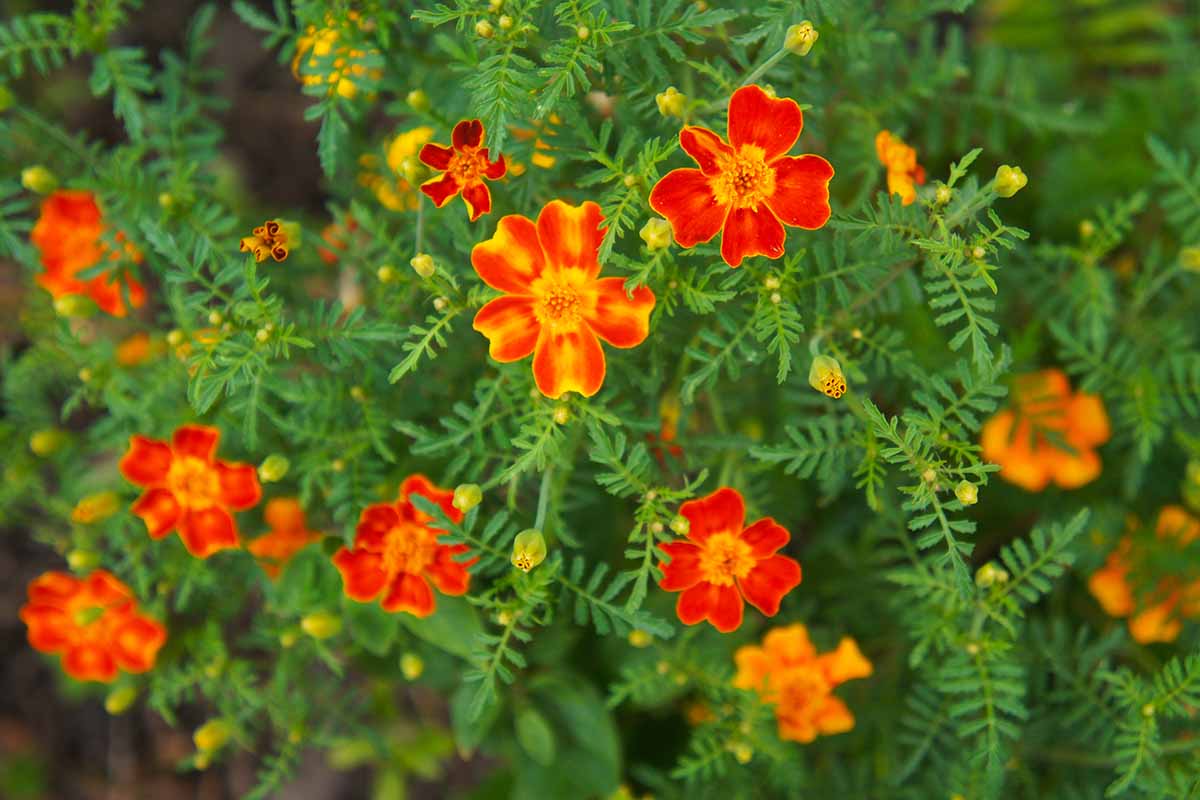
If you want to save your own seeds for next year, you can stop deadheading in early October in order to have seeds that are ready to harvest right before the first frost.
Apply two inches of organic mulch to the soil around your signet marigolds to keep the soil moist and to prolong the amount of time between required waterings.
I also recommend pruning your plants as needed to keep them contained within the desired planting area. These are prone to spreading if you don’t keep an eye on them.
Since signet marigolds are annuals, they will need to be removed from your landscape after they’ve died back in the late fall or early winter.
Series and Cultivars to Select
The Gem series hybrids are the most popular commercially available type of signet marigolds.
They come in four different selections which include ‘Tangerine Gem,’ ‘Lemon Gem,’ ‘Red Gem,’ and ‘Orange Gem.’
These compact cultivars have a dwarf size that can help keep your T. tenuifolia from spreading in an unmanageable way.

You can find both seeds and transplants from local nurseries or online. If your local nursery carries them, they are generally sold in the spring, and seeds are sold year-round.
Lemon Gem
‘Lemon Gem’ has bright, lemon-colored petals that can really bring the sunshine into your garden, or they may be used as a garnish on your plate.
Seeds are available from True Leaf Market.
Red Gem
‘Red Gem’ is my personal favorite because of the vividness of the red petals. It’s dramatic, and I love it!
You can find this variety available in a mixed seed blend from Botanical Interests.
Tangerine Gem
‘Tangerine Gem’ has a beautiful sunburst color, moving from a warm orange in the center to lemony yellow-tipped petals.
You can buy seeds as part of a Gem Mix from True Leaf Market.
Managing Pests and Disease
Similar to other marigolds, signets are vulnerable to certain types of pests and diseases. Let’s review some of the main ones you might have to deal with.
Herbivores
While they are technically deer and rabbit resistant, the lemony scent of T. tenuifolia will sometimes lead herbivores to explore and nibble at the flowers or leaves.
They’ll mostly leave these plants alone, but if you’ve experienced something different, I’d love to hear about what happened in your garden in the comments below!
Other Pests
Some of the most common insect pests and gastropods that may plague your plants include:
Aphids
Aphids are tiny garden pests that can cause big problems for your plants if you don’t actively manage them.
Neem oil is an excellent organic choice to stop an aphid infestation. It does a great job of keeping all kinds of pest insects out of your garden and works best when applied at the first sign of infestation.
You can usually find neem oil in a concentrated form that you can mix with water to be applied with a spray bottle. Prepare your neem oil solution as described on the product packaging and spray heavily all over your plant.
You’ll want to reapply it every seven days until the pests are gone.
A high-quality neem oil concentrate from Bonide is available from Arbico Organics.
Slugs and Snails
These slimy creepy-crawlies will gobble up your signet marigolds if they find them. They will usually emerge at night or during overcast days when it’s cool.
You’ll want to stick with organic solutions as much as possible, particularly if you plan to harvest the flowers for edible use, but also because snails and slugs are food for birds.
There are two main ways to organically combat snails and slugs in your garden without picking them out by hand: using beer traps, and snail den traps.
Beer trapping is pretty straightforward. Place a shallow dish in your garden near the affected area and fill it with some cheap beer (don’t use the good stuff!). The slugs and snails will be attracted to the beer, go in for a sip, and drown. Remove their dead bodies the following day and refill your tray with more cheap beer.
In our guide to slug and snail control, we recommend this adorable ceramic snail trap by Esschert that’s available via Amazon. A flat tray or dish will work just as well, but why not choose a more decorative option and make your pest control a bit more fun?

Snail Shaped Ceramic Slug Trap
Secondly, let’s talk about snail den traps. The idea is to create a nice haven for these pests to go during the day.
You’ll want to allow at least 48 hours to pass before returning to your den trap, preferably during the day when they’re most likely to be hiding. Then you can then hand pick them and dispose of them.
To make a snail den trap, water the area and place something flat and thick on the moist ground like a piece of plywood, plant saucers, or thick plastic sheeting.
Place some bait that they like to feed on beneath your item, like melon rinds or grapefruit pieces. Return in two days, lift up your trap, and remove any snails or slugs you find beneath it.
Spider Mites
Spider mites are the most prevalent pests when it comes to marigolds. They will usually pop up in the middle of summer when the temperature is the hottest, and they favor dry conditions.
You’ll know your plant is dealing with a spider mite infestation if the leaves begin losing color and you see fine webbing on the leaves and flowers.
For this edible plant, I recommend an organic solution rather than using chemical pesticides on the flowers. Assassin bugs and lacewings serve as spider mite predators.
You can find Zelus renardii assassin bug eggs available from Arbico Organics in various package sizes.
Lacewing larvae are also available from Arbico Organics. You’ll apply these to your infested plants and the insects will do the rest.
Thrips
Thrips are members of the Thysanoptera order, also known as the bane of my existence. A thrips infestation is no fun, but there are solutions to treat your signet marigolds.
The easiest way to tell if you have a thrip problem is if you start to notice scarring on your flowers, or deformed leaves.
If you find thrips on your marigolds you can treat your plant with neem oil as described above. This natural solution really works wonders.
Disease
Luckily, signet marigolds are moderately disease resistant. But they are susceptible to botrytis blight and root rot.
Botrytis Blight
Botrytis, or gray mold, is a fungal disease that can affect the leaves, buds, and flowers. It is one of the more difficult fungal issues to deal with.
This mold usually starts by colonizing dead, dying, or wounded parts of the plant. A moist and humid environment is ideal for mold spores to spread, attacking the healthy parts of your plant as well.
If you’re dealing with botrytis on your marigolds, you’ll first want to prune off and burn the affected parts of the plant.
If you’re unable to burn plant waste in your area, bury the affected pieces one foot deep into the ground or dispose of them in the garbage – not on the compost pile.
Disinfect your shears between cuts when you are pruning, to avoid spreading the spores.
After pruning, you can try treating your signet marigolds with a biofungicide, but note that these are best used as a preventative to protect your plants from infection rather than a curative.
Regalia, a broad-spectrum biofungicide that’s available from Arbico Organics, isn’t harmful to beneficial insects and it can also be used to fight against bacterial infections. It’s made with an extract of giant knotweed (Reynoutria sachalinensis).
Follow the directions on the product packaging for application instructions.
Now, full disclosure: there are no guarantees that you’ll be able to rid your signet marigolds from this fungal infection once it’s established.
If you apply a treatment to your signet marigolds and they are still struggling with botrytis, I recommend removing and burning or otherwise discarding your plants, and starting anew with fresh soil and a sanitized pot.
Root Rot
A gardener’s worst nightmare – root rot! This issue can sometimes mean that you’ve loved your plant too hard by overwatering it. Or, maybe you’ve planted your marigolds in soil with poor drainage that needs to be replaced.
Signs of root rot include sudden wilting of the stems or leaves that turn yellow.
My best advice for fixing this issue is to remove the marigold from its environment, and remove any dead or dying plant parts with a sterile pair of shears.
Whether your plant is growing in your landscape or in a container, dig it up and turn it upside down to inspect the roots. If the rot is severe, carefully cut out the decaying roots with sterile shears, but try to keep as much of the roots intact as you can.
If you find that the issue is overwatering, remember to only water when the top two inches of soil are dry. If you prefer to take the guesswork out of this process, purchase a moisture meter.
I use this 3-in-1 moisture meter from Trazon that’s available on Amazon and it’s completely changed my watering habits. I don’t like guessing, and this tool fixes that!

If you find that the soil around the plant isn’t draining well enough, remove the soil and replace it with a soil mixture that’s more porous. Adding sand, perlite, or grit can help to improve drainage.
Best Uses
Not only do signet marigolds make beautiful ornamental plants, they also make wonderful additions to your vegetable or herb garden. Like many types of marigolds, they can help to repel pests.

They have similar care requirements to many other types of edible plants, which is another plus when including them in your garden.
Since the flowers are also edible, usually used as an aromatic garnish, this is a good choice for gardeners looking to have their cake and eat it too.
I’ve also read that you can infuse the flowers in an oil and vinegar mix to be used as a salad dressing. Delicious!
Quick Reference Growing Guide
| Plant Type: | Herbaceous flowering annual | Flower/Foliage Color: | Golden yellow, deep red, orange, bicolored/bright green |
| Native to: | Mexico, Central America | Maintenance: | Moderate |
| Hardiness (USDA Zone): | 2-11 | Tolerance: | Drought |
| Season: | Spring-fall | Soil Type: | Average, moderately fertile preferred |
| Exposure: | Full sun | Soil pH: | 6.5-7.0 |
| Time to Maturity: | 75 days | Soil Drainage: | Well draining |
| Spacing: | 10 inches | Attracts: | Bees and butterflies |
| Planting Depth: | 1/4 inch (seeds), depth of root ball (transplants) | Companion Planting: | Basil, cucumbers, kale, melons, potatoes, snapdragons, tomatoes |
| Height: | 12-20 inches | Uses: | Ornamental, edible flower, pest control |
| Spread: | 12 inches | Family: | Asteraceae |
| Water Needs: | Moderate | Genus: | Tagetes |
| Common Pests and Disease: | Slugs, snails, spider mites; botrytis blight, powdery mildew, root rot | Species: | Tenuifolia (syn. Signata) |
Let’s Grow!
Signet marigolds are full of color and flavor. They are vigorous growers that only require some water, sun, and a bit of pruning if you desire.
And they are more than happy to help you deter pests from your veggie patch, in addition to giving you a unique garnish for your summer and autumn meals.

You can easily grow them from seed, either indoors or by directly sowing them into the ground. If starting your seeds indoors, you’ll want to begin this process a few weeks before the last frost in your growing zone.
For beginner gardeners, this plant offers all the benefits of growing a showy ornamental that can also be used as an edible plant. If you’re just starting out in the garden, it’s an excellent plant to practice your skills on.
I hope you’ve enjoyed reading about signet marigolds in this guide! I’d love to read about your experience with growing this plant, so please comment below with your own insights.
And for more information about growing marigolds, check out these guides next:

